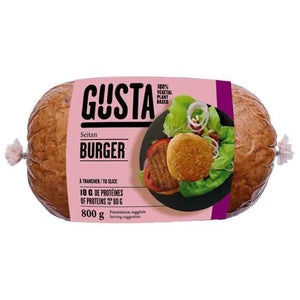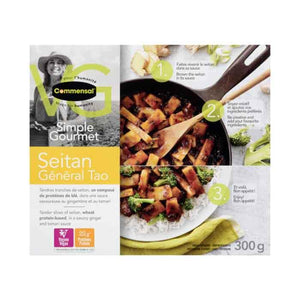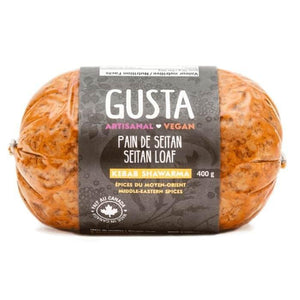Seitan
Seitan, a fantastic vegan meat alternative, originated in China and is referred to as miànjīn (which translates to dough tendon). The Chinese needed seitan because it was common in the Buddhist religion to practice a vegetarian diet. This is also true for the Japanese and Vietnamese who, although they ate seitan during ceremonies and daily meals, used it for Buddhist vegetarian cooking most of all.
Even though it has religious origins,... Read more
Sort By ×
- Featured
- Price, low to high
- Price, high to low
- Alphabetically, A-Z
- Alphabetically, Z-A
- Date, old to new
- Date, new to old
- Best Selling
seitan ended up widely consumed for its versatility as an ingredient. Read on because we’ll drop some helpful tips as well as some more knowledge about seitan products!
How Is Seitan Made?
Seitan is known by many names. You can call it gluten, gluten meat, vital wheat gluten, and wheat meat. You can get seitan by washing wheat flour dough in water until its elasticity changes. Once this elastic and sticky form is achieved, you can cook it to get the vegan meat known as seitan.
When you buy seitan, you’ll most likely notice its chewy and stringy texture. This is why seitan is more commonly used as a vegan duck alternative, which its texture closely imitates. But seitan can also be prepared in different ways, allowing it to be an alternative for other meats like pork, too.
Useful Tips & Variations
In Chinese cuisine, you can buy seitan that’s been baked, steamed, or fried. The Japanese forms of seitan come either raw or dry baked. Japanese baked seitan and Chinese baked seitan actually have different textures, so we’ll be discussing them separately.
Here, we’ll go over the differences among these five ways that seitan can be cooked!
Steamed Seitan
Steamed seitan is often rolled into a sausage-like form before steaming. After cooking, it is cut up into small circles (some call them wheels or medallions) and then served with some veggies. Alternatively, you can cut seitan into strips before steaming. This would give you noodles! You can use your seitan noodles to make a traditional Chinese dish called liáng pí.
Fried Seitan
This method means that you fry your seitan products in oil. Seitan vegan meat can be shaped to create rolls or balls, stuffed with ingredients, and then fried. When you buy seitan from the supermarket, chances are that frying them is often the easiest way to go.
Baked Seitan
Baked seitan is often used to create a spongy texture more similar, though not exactly, to tofu. Baked seitan is often diced and its spongy texture allows it to soak up the flavor of broths and stews.
Dry-Baked Seitan
Dry-baked seitan is a Japanese take on this wheat meat. It is lighter and fluffier than its Chinese counterpart. Similarly, though, it is often eaten in soups like miso soup. It is also a common ingredient in sukiyakis. You can buy seitan like this in Japanese stores or here at PlantX!
Raw Seitan
Why buy seitan that’s raw? Well, raw seitan is commonly used to make confectionery in Japan that’s called manjū. The best way to describe this is that it’s like mochi because it’s got that semi-chewy exterior with different types of filling.
Benefits Of Seitan
For folks looking for soy-free meat alternatives, seitan is a godsend. A lot of vegan meats out there contain and are made up of soy, which is unfortunate if you can’t have it. That’s why it’s great to have options like wheat gluten, or seitan.
Even knowing its benefits, one should be aware that people with gluten intolerances or celiac disease cannot and should not have seitan products for fear of negative side effects. Whenever you’re shopping on our website, you have the option to filter through products and tick the "gluten-free" box on the left. That should be very useful if you’re only hunting for gluten-free alternatives!
Nutritional Facts of Seitan
One of the well-known benefits of seitan is that it’s full of plant-based protein. One serving of 85 grams will contain 15 to 21 grams of protein. That protein content is already similar to what you’ll get by eating chicken or beef! Seitan vegan meat is also a source of iron, carbs, and calcium.
If you’re looking for a low-calorie meat alternative, buy seitan. With that same serving (85 grams), you’re only getting about 315 calories. The final calorie count would really depend on the accompanying ingredients you’re having with seitan vegan meat, but this protein-packed meat alternative is a fantastic choice for building beautifully balanced plant-based meals.
What Dishes Can You Make With Seitan?
For this tantalizing little section, we’ll have some tasty dish recommendations with some of the seitan products we carry here at PlantX. Often, seitan products can easily replace the meat or meat alternative products that you’re already used to using.
Here’s a great example to start off with. Sweet Earth’s Hickory & Sage Seitan Bacon is our entry for seitan products that are breakfast-friendly! This smoky treat can be enjoyed with some vegan eggs, meat-free sausages, and a couple of toasted bread slices à la your standard American breakfast!
Seitan Strips by Sweet Earth strip cholesterol from your diet. When you buy seitan strips like these, you’re still getting all that tasty plant-based protein, but with non-GMO ingredients! You can get it in a traditional or chipotle style, making it a fantastic hero ingredient for stir-fries, salads, and fajitas.
When we’ve got Blackbird’s Seitan, we take that opportunity to make American or Mexican-inspired recipes. We just have to! Treat this like pulled meat. So, with the three different flavors bursting with flavor you can make everything from juicy burgers to burritos and soft tacos!
Frequently Asked Questions
Is seitan gluten-free?
Seitan, also known as wheat meat or gluten meat, is 100% not gluten-free. Seitan is a versatile meat alternative that can be enjoyed by vegans and non-vegans alike. Best to avoid if you have any gluten intolerance, though! We have plenty of fantastic gluten-free options for you to choose from though if you should need them. Just try using the Gluten-Free filter in the Vegan Meat section of the website.
How can you use seitan in cooking?
There are many different foods you can enjoy when you buy seitan. The abundance of seitan products in the market means that you can cook or prepare seitan similarly to how you normally prepare your fave dishes.
Want to make a lovely vegan steak dinner? You can marinade your seitan vegan meat and fry it in the skillet to achieve the same thing. How about some pasta? You can cut your seitan into strips or buy seitan that’s been pre-made and then simply add that to your dish. Want to add some protein to your fresh salad? You could buy seitan, grill it up, and add that to your greens.
Is eating seitan every day bad for health?
Mark Twain was once quoted as saying, “Too much of anything is bad…” That holds true for seitan! While it’s a great substitute for meat and made with plant-based ingredients, some seitan products come heavily seasoned to help them taste better and closer to real meat. They could be loaded with sodium, and eating too much may be bad for you.
If you buy seitan that’s not been pre-seasoned or you made the seitan yourself, healthy servings might be alright. Put simply, don’t go overboard and enjoy seitan as part of a healthy, balanced diet.
Is seitan hard to digest?
Not really, no! You may have come across some reading materials that say eating could lead to digestive issues. That’s not always the case. If you do experience some bloating or discomfort after eating seitan, then it’s best you limit the amount you eat or consider other meat alternatives.
Generally, however, seitan usually digests pretty well if you don’t have intolerances or underlying digestive conditions. Don’t knock it ‘til you try it!








